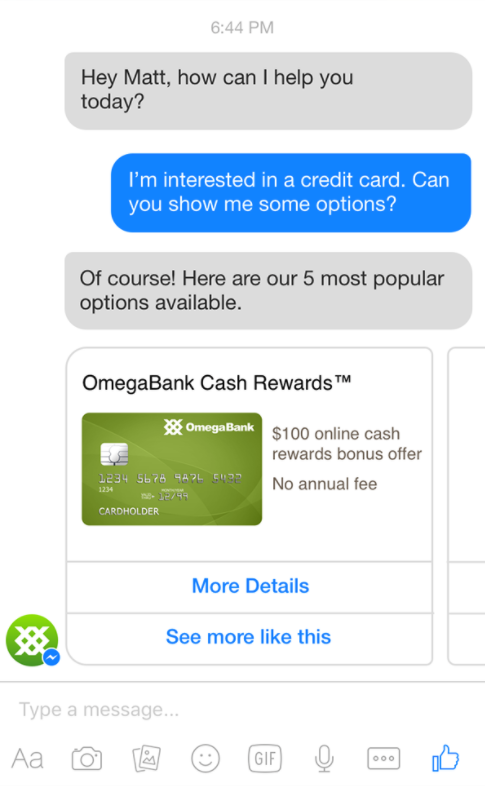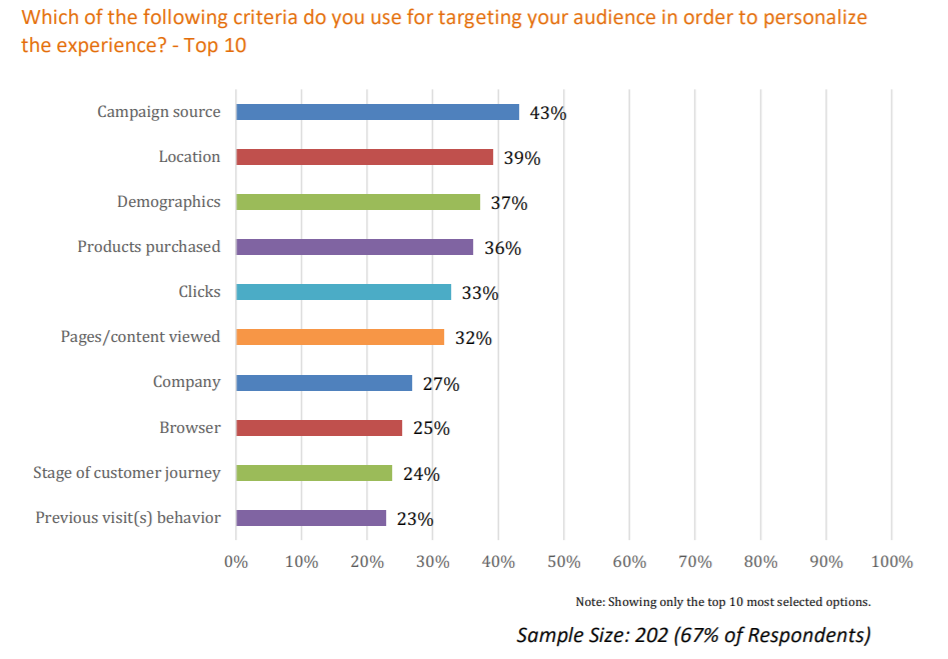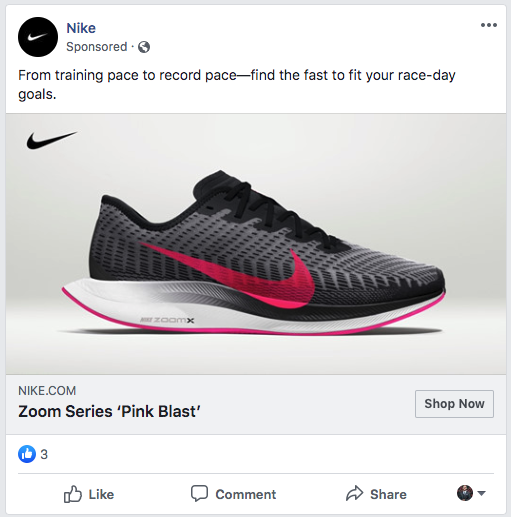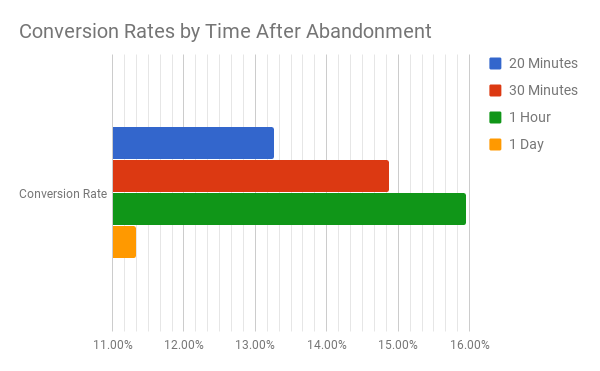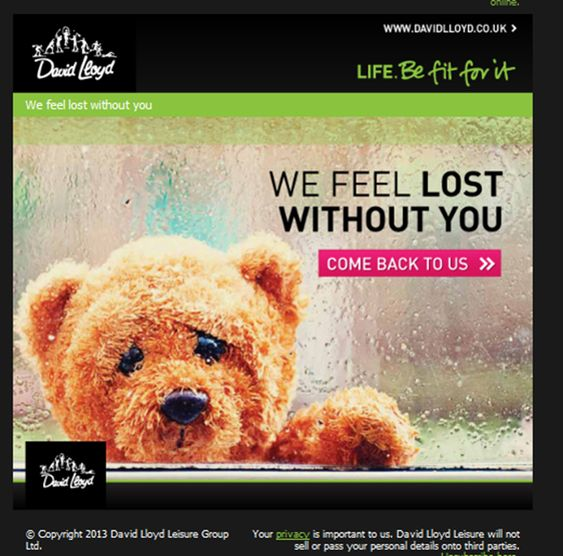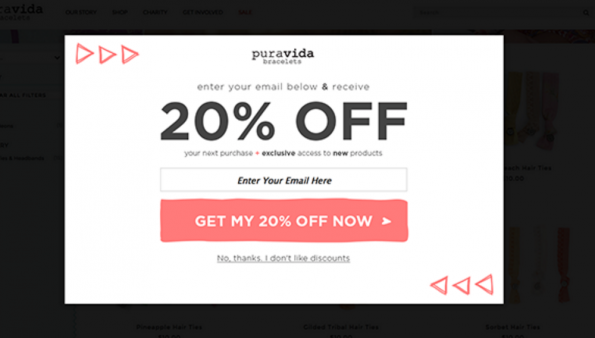When setting out to create a new marketing campaign, the most important question should always be:
Who are you targeting?
Now, in answering that question, it’s not uncommon for marketing teams to immediately start rattling off information about the target’s demographics. After all, you need to be able to describe who your target is if you want to be able to reach them, right?
Yes, demographic targeting is vital to the success of your marketing campaigns; we’ll come back to this later). However, stopping at a mere description of your target consumer as they appear “on paper” will cause you to miss out on some major sales opportunities over time.
You also need to consider how your target consumers think, feel, and act as they engage with your brand. In turn, you’ll be able to reach them at just the right moment, with just the right offer to get them to convert.
Which is where behavioral targeting comes in.
What is Behavioral Targeting?
Behavioral targeting (or, behavioral marketing) is the process of marketing to your individual customers once they take a specifically-defined action.
For ecommerce companies, “action” refers to most anything the customer may do while browsing the company’s website—and can also refer to actions taken on the web after they’ve visited the site.
There are three core aspects of behavioral targeting to consider as you implement it into your overall marketing playbook:
- Trigger: The behavior exhibited by the consumer that signals a new marketing opportunity
- Offer: The content or promotional offer you’ll deliver once the consumer takes the defined action
- Logistics: When you’ll deliver your offer (in relation to when an action took place), as well as how (i.e., on what platform) you’ll deliver it
Behavioral marketing, then, can manifest itself in a variety of ways, such as…
On-site popups:
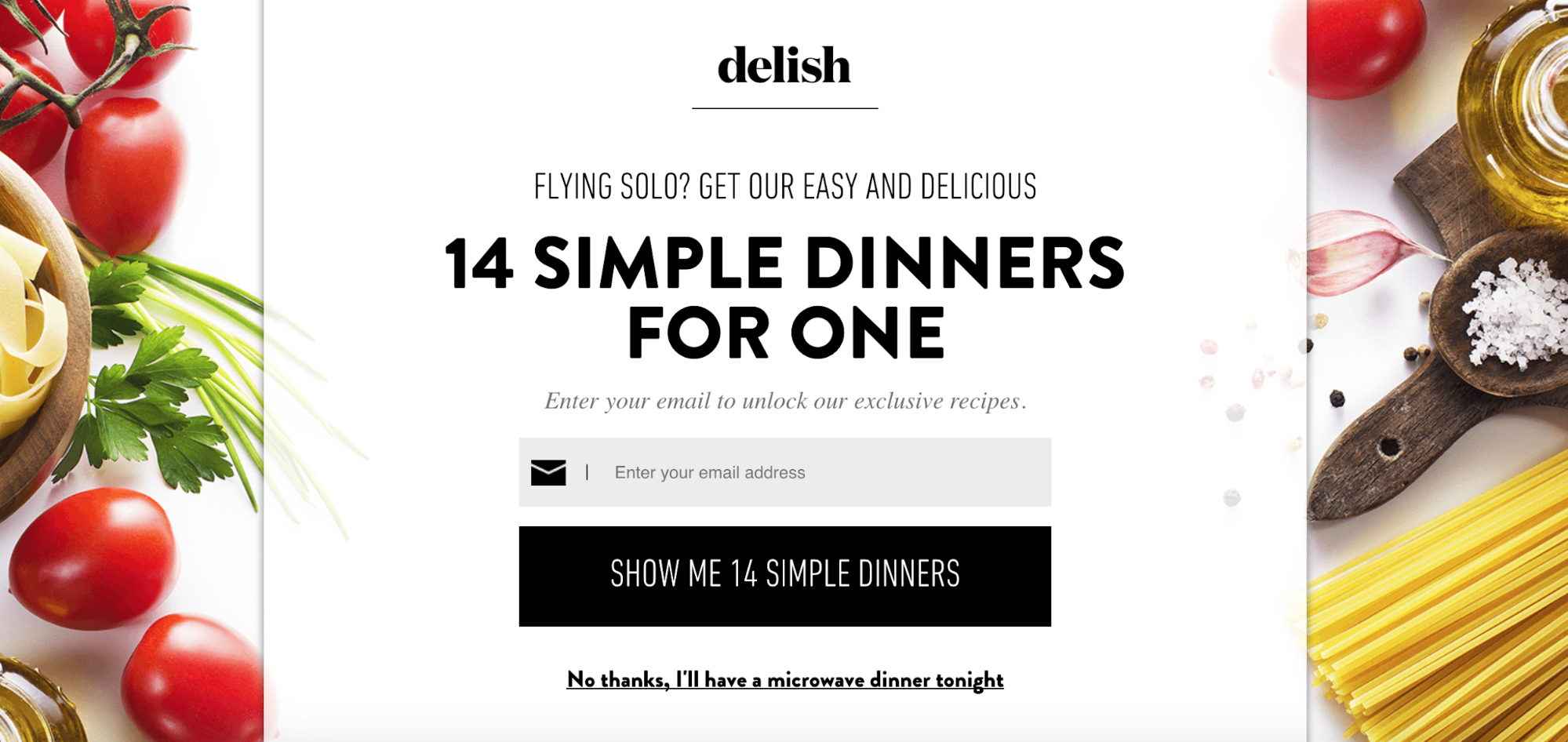
Retargeting ads:
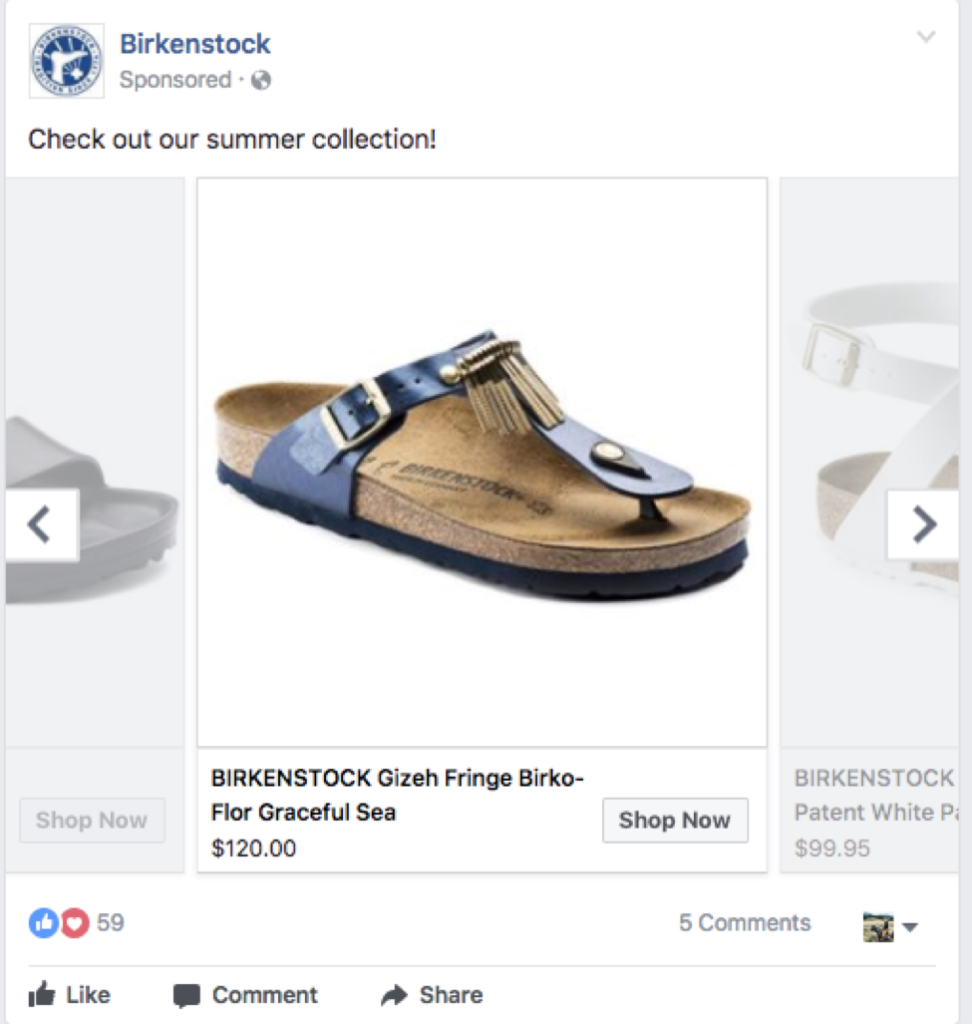
Email follow-ups:

Chatbot or Live Chat engagements:
In each of these cases, the content or material was delivered due to a specific action taken by the customer.
Some possible scenarios:
- The visitor was inactive for a certain period of time on-site, triggering the pop-up.
- The visitor clicks on a certain product page, triggering a retargeted ad featuring the product in question to be displayed at a later time through social media.
- A potential customer adds a number of items to their cart, but leaves the site before finalizing their purchase. This triggers a cart abandonment email to be sent at some point in the near future.
- After a visitor has clicked around on the website for a certain period of time, the chatbot can be triggered to provide further assistance as needed.
Again, these are just possible scenarios in which behavioral targeting can be used to engage those who take a specific action. With your ecommerce customers taking all sorts of action both on your site and around the web, there’s a lot to consider, here.
But don’t panic.
First of all, optimizing your behavioral marketing campaigns isn’t that difficult. Once you understand how to implement it for your audience, it will become second nature.
Secondly, behavioral marketing just works. As a report from Gallup shows, companies that apply behavioral economics outperform their competition in sales by up to 85%. In other words, if you know how to engage with your customers based on the actions they’ve taken, you’ll be able to get them to convert with relative ease.
As effective as behavioral targeting can be, many marketers have yet to truly optimize their approach to segmenting by behaviors. As a 2018 report from Evergage shows, behavioral data often takes a backseat to the more “on-paper” data we mentioned earlier.
But, recent data from Econsultancy shows that 55% of marketers have made it a top priority to get better use out of customer data for more effective targeting purposes. In other words, even if your competitors haven’t mastered behavioral targeting just yet, they’re well on their way to doing so.
That said, it’s essential that you know how to use behavioral targeting to attract, engage, and convert your customers at the optimal times throughout their buyer’s journey.
With that in mind, let’s now take a look at five key ways to optimize your approach to behavioral marketing—and five key things to avoid.
5 Key Dos and Don’ts When Using Behavioral Targeting to Improve Ecommerce Engagement and Sales
To be clear:
There’s no “one way” to do behavioral marketing.
- Your customers might not behave the same way consumers in other niches do.
- Your customers might be more or less engaged at certain points along their individual journey with your brand
- Your customers might value different offers as presented by your brand at various times throughout their buyer’s journey
While behavioral marketing will look different from company to company, there are a number of universal best practices to follow as you implement it into your organization.
(There are also a number of pitfalls to avoid as you do so, too.)
Without further ado, let’s dig into five key things you need to know as you get your first behavioral marketing campaign off the ground.
1. Do Get Permission; Don’t Be Creepy or Annoying
Whether or not you operate in an area where stringent privacy laws are in place, it’s essential that you receive permission from your individual customers before you begin targeting them based on behavioral triggers.
For one thing, you’ll often have to get their permission from a logistical standpoint. You can’t email them if you don’t have their email address, right?
(Similarly, you can’t retarget them if they haven’t accepted cookies from your site, either.)
Equally as important: The modern consumer wants to receive personalized marketing content—so long as they give permission. As data collected by Hubspot shows, 57% of consumers will allow for the collection of personal data if it’s used responsibly and to enhance their branded experience.
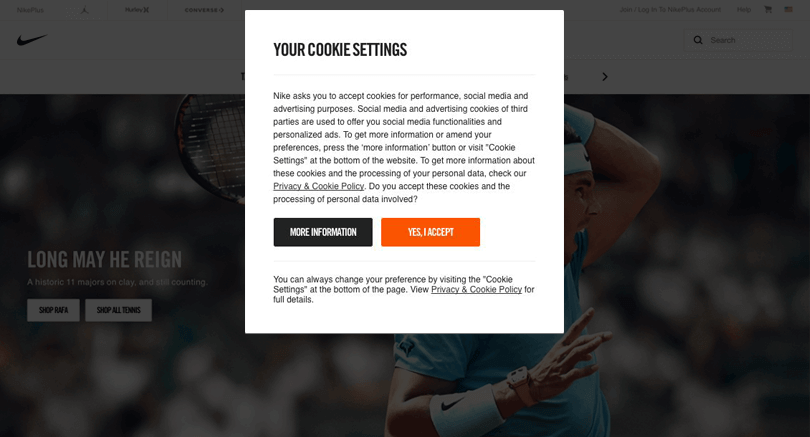
In the above example, Nike explains that, via cookies, the customer’s on-site actions will be used for social media marketing and advertising purposes—while also making clear how the customer will benefit. Then, using remarketing via Google, social media, and other platforms, Nike can present targeted ads based on the individual’s browsing history.
Now, in some cases, you’ll need to act first, then ask permission to go a bit deeper in terms of behavioral targeting. For example, you might immediately display a pop-up to first-time visitors that provides a basic offer in exchange for their contact information.
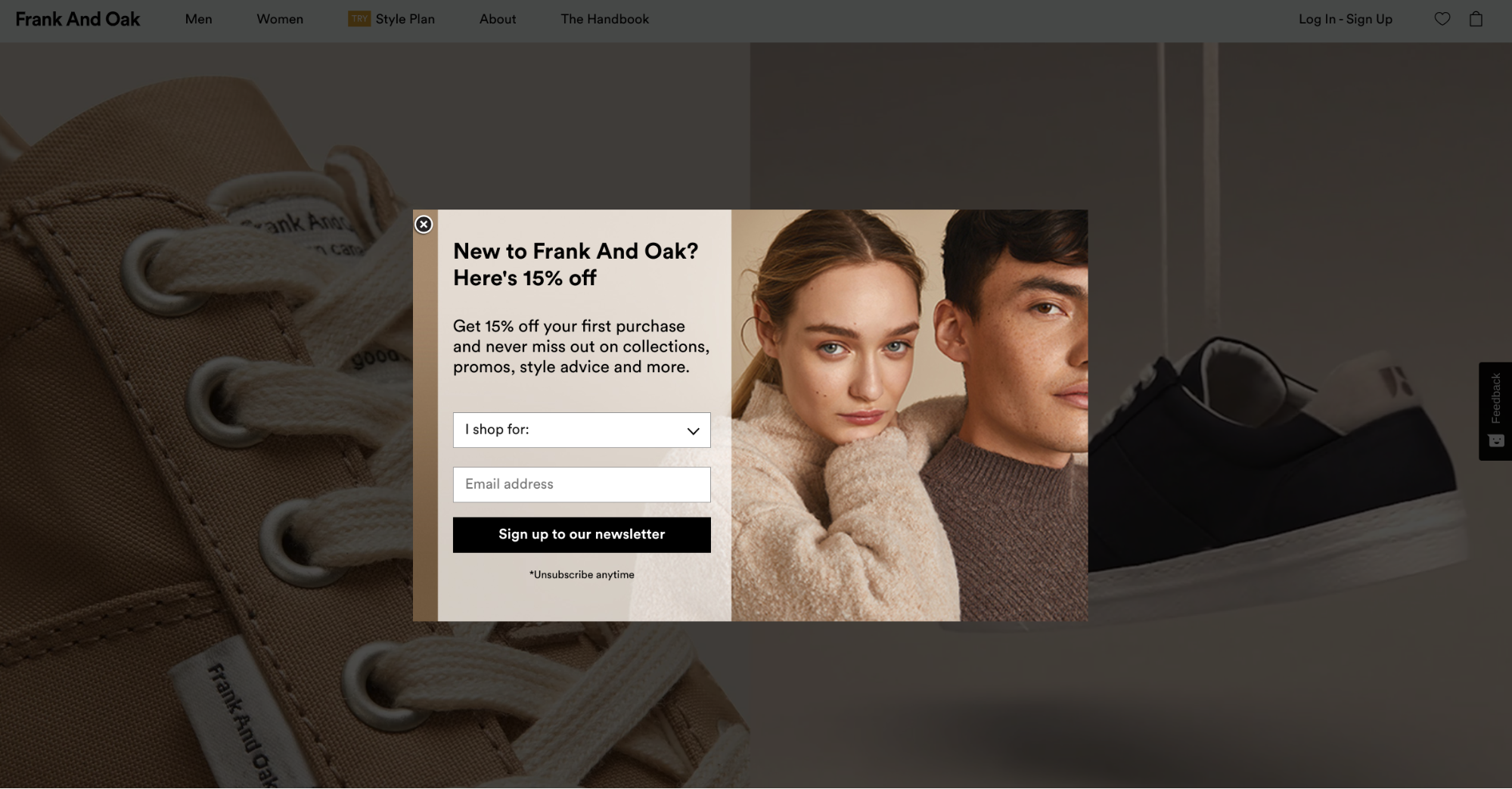
Once you have this permission, you can begin delivering offers, promotions, and other content via email (and other channels, as defined by your terms) at optimal moments throughout your customer’s journey.
Okay, so:
You have your customer’s permission to engage with them based on their on-site (and off-site) actions.
That doesn’t mean you should go overboard, though. If you’re constantly reaching out with automated messages after every little step a customer takes, you’re going to be more distracting and annoying than engaging and inviting.
We’ll come back to this in a bit when discussing how to identify optimum moments for engagement. For now, the message is this:
Don’t neglect your audience’s right to privacy, and don’t abuse the permission they’ve given you when implementing your behavioral targeting campaigns.
Instead, be clear about what the customer stands to gain from your use of their behavioral data—then focus on giving them what they signed up for.
2. Do Use Demographic Data; Don’t Be Generic
Earlier, we talked about how persona-based marketing and behavioral marketing are sometimes approached as if they’re separate from one another.
And, to be sure, if you’re just getting your behavioral campaigns up and running, you might not be thinking about segmenting your audiences even further via demographic info. As we’ll discuss further in the next section, you’ll want to ensure you’ve gotten your triggers and timing down for your general audience first and foremost.
But:
You eventually want to create campaigns that take both demographic and behavioral data into consideration.
The following exit-intent popup, for example, is likely based entirely off of behavioral data (i.e., have added items to their cart, have attempted to leave the site, and have yet to take advantage of the company’s free shipping offer):

Now, by no means is this a poor example of behavioral targeting. In fact, it’s likely pretty effective in its own right.
But, by bringing demographic and other persona-related data into the mix, you can create even more targeted behavioral campaigns for your individual customers. Basically, this means creating nearly-identical behavioral campaigns for your various personas—then delivering the right version to each demographic as appropriate.
For example, you might know that a given customer segment is more apt to engage with offers of monetary value (as opposed to offers of free shipping, as shown above). So, in lieu of offering free shipping as an exit-intent incentive, you might offer $10 or 10% off their next purchase.
The takeaway here is:
By adding an extra layer of data to the scenario, you can actually develop multiple behavioral campaigns in one—each nearly identical, but using a separate, unique offer to engage your differently-minded customers.
In taking both your audience’s persona-based and behavioral data into consideration, you’ll always be able to figure out the best way to reach out to your individual customers at the moments when they’re most likely to engage.
3. Do Identify Optimum Moments; Don’t Haphazardly Define Triggers and Timing
Speaking of reaching out at the exact right moment, well…that’s what behavioral marketing is all about.
Now, we’ve alluded to some of the most common touchpoints that behavioral marketing often revolves around, such as:
- First-time visits
- Extended browsing periods
- Exit-intent actions
- Cart abandonment
- Conversions/Purchases
…and the list goes on.
However, while these (and other) common touchpoints are prime moments for engaging in general, you need to get a bit more granular when assessing your specific circumstances.
This applies in two ways:
First, you need to identify moments in which your specific audience is most engaged, or is most apt to engage further—or when engagement is likely to fall off. In other words, don’t use a certain tactic (e.g., an exit-intent popup) simply because it “seems like it might be worth trying” or because “everyone else is doing it”; use it because you know it’ll work at a certain point in time.
Yes, generally speaking, exit-intent popups often do work to re-engage site visitors before they leave. Retargeting ads absolutely work wonders for keeping brands at the top of their audience’s mind. And cart abandonment emails can increase the chances of nearly-converted prospects coming back to your site to seal the deal.
But:
None of this is guaranteed.
So, before you start focusing on every behavioral targeting touchpoint under the sun, take the time to identify which are most critical to your audience’s buyer’s journey.
Think about the actions they take or the behaviors they exhibit as they’re about to:
- Engage further with your site in some way
- Move toward making a purchase
- Abandon their browsing session and/or purchase altogether
Once you’ve identified your optimal trigger moments, and you know which tactic to use for such moments, you’ll want to get even more specific with regard to your timing of delivery.
In some cases, you’ll want to deliver your behaviorally-triggered content almost immediately. Exit-intent popups, for example, must be displayed within seconds of the trigger behavior—or the customer will leave your site before they even see your offer.
In other cases, you might be better off waiting a bit before presenting your behavioral marketing-related offers. For instance, cart abandonment emails are typically most effective when sent anywhere from a few hours to a full day after the trigger behavior took place. That said, sending such an email right after a prospect abandons their cart will most likely come off as overbearing—and, again, fairly annoying.
Now, you of course aren’t going to know exactly when these optimal moments for delivery are right off the bat. But, that doesn’t mean you should simply stick with the “typical” approaches to timing that work for the average online consumer.
Instead, start conservatively, then your timing based on the results you gather over time. This will allow you to find the optimal moment to deliver an ad, offer, or piece of content after a customer takes a specific action—and fine-tune your behavioral campaigns as needed.
4. Do Align Behaviors, Triggers, Channels, and Devices; Don’t Isolate the Customer
The push toward omnichannel marketing will only continue into 2020 and beyond—because it’s exactly what the modern consumer wants.
As data collected by V12 shows:
- 98% of consumers switch devices throughout the day, and throughout their path to purchase
- Consumers use an average of six touchpoints along their path to purchase today
- 90% of customers expect consistent interactions across channels
Incidentally, brands that provide an omnichannel experience to their customers see an astounding 91% higher year-over-year retention rates than those that do not.
So, when developing your behavioral marketing campaigns, think of how the channels and devices your customers use play into the matter. Again, this all depends on your audience’s preferences and behaviors—meaning you’ll need a clear understanding of what their path to purchase looks like in order to optimize your behavioral campaigns.
There are two things to think about, here:
For one thing, you want to use the channels that your customers prefer to use. This will increase the chances of their engaging with your ad, promotion, etc.—and, ideally, of moving forward in their path to purchase.
For example, you might deliver a cart abandonment reminder to one audience via email, while delivering it to another via push notification. Or, you might target another segment via Messenger chatbot.

Secondly, consider which channel provides the most efficient way for you to deliver your content or offer—and the easiest path to engagement for the recipient.
Going back to the above example, while a given customer might prefer to engage with your brand via email, they might check their Facebook messages more often—and would be more likely to receive and engage with your offer if delivered via this channel.
As we alluded to earlier, it’s important to clearly define your delivery channels in order to avoid redundant cross-channel messaging. For example, sending an abandoned cart reminder via email, Messenger, and push notification would almost certainly annoy the customer to the point of frustration.
That said, you certainly should use multiple channels at different times, depending on the customer’s actions, and/or their response to your outreach efforts.
Using the above example, if the recipient doesn’t open or respond to the abandoned cart reminder via Messenger in a certain amount of time, you might then send a follow-up reminder via email. Here, you’d refer back to the original notification so as to maintain continuity and alleviate any sense of redundancy in your messaging.
The device on which your customer exhibited a trigger behavior is important, as well. For example, a not-yet-converted customer may be more susceptible to a mailing list popup when browsing via desktop, but more likely to engage with a remarketing ad when using a mobile device.
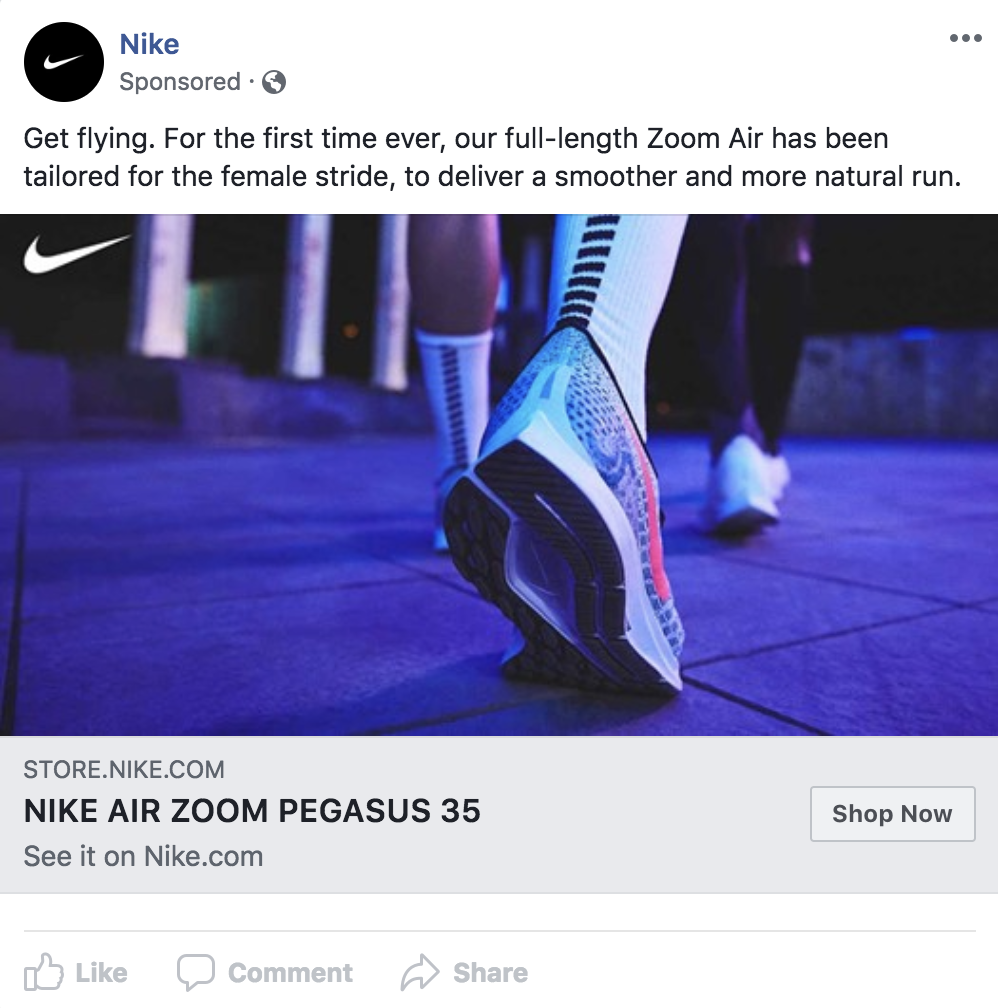
So, to review, think about:
- Which channels your targets prefer and are most likely to engage on
- Which channels allow you to most efficiently and effectively deliver your message
- How the device your target uses when exhibiting a trigger behavior factors into the above equations
Again, figuring all this out will require some testing and tweaking—but it will enhance your ability to your triggered offers to your target audience on any channel, and any device.
5. Do Focus on a Call-to-Action; Don’t Forget About Value
Behavioral targeting is all about striking when the iron’s hot—that is, when conditions are optimal for you to nurture a given customer further along in their buyer’s journey.
So, when the opportunity arises (i.e., an individual exhibits a trigger behavior), you need to get your target focused on the next steps to take in their journey.
Now, depending on where your target is in the sales funnel, the “next step” could be a variety of things:
- A first-time site visitor would need to provide permission for data collection, and provide their contact information to begin receiving mailing list content
- A potential customer’s next steps would, of course, be to make an initial purchase
- Long-time customers may need more info on complementary or more valuable products—or may be ready to make an additional purchase immediately
Your goal, then, is two-fold:
First, focus on the value of your offer. Illustrate what your target will receive by engaging further with your ad or content—and what they’ll be able to do by taking the next step in their journey.
For example, MeUndies sends prospective-yet-hesitant customers a 20% discount, along with a money-back guarantee:
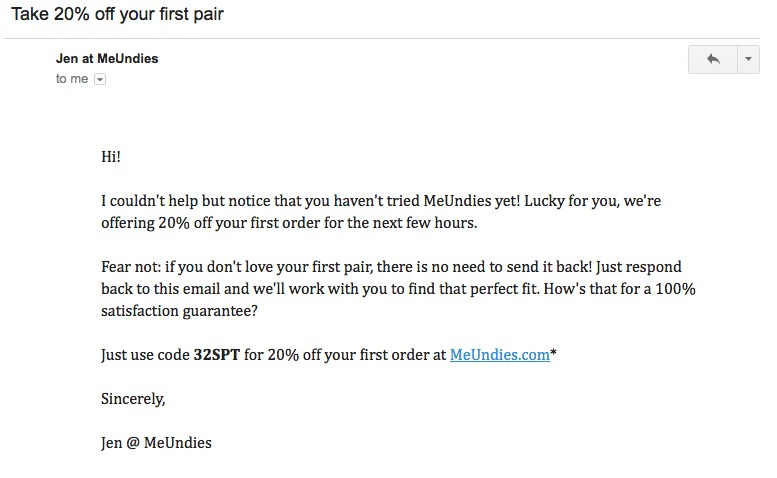
For first-time visitors, though, MeUndies dials it back a bit, and focuses on getting the individual to sign up for the company’s mailing list:
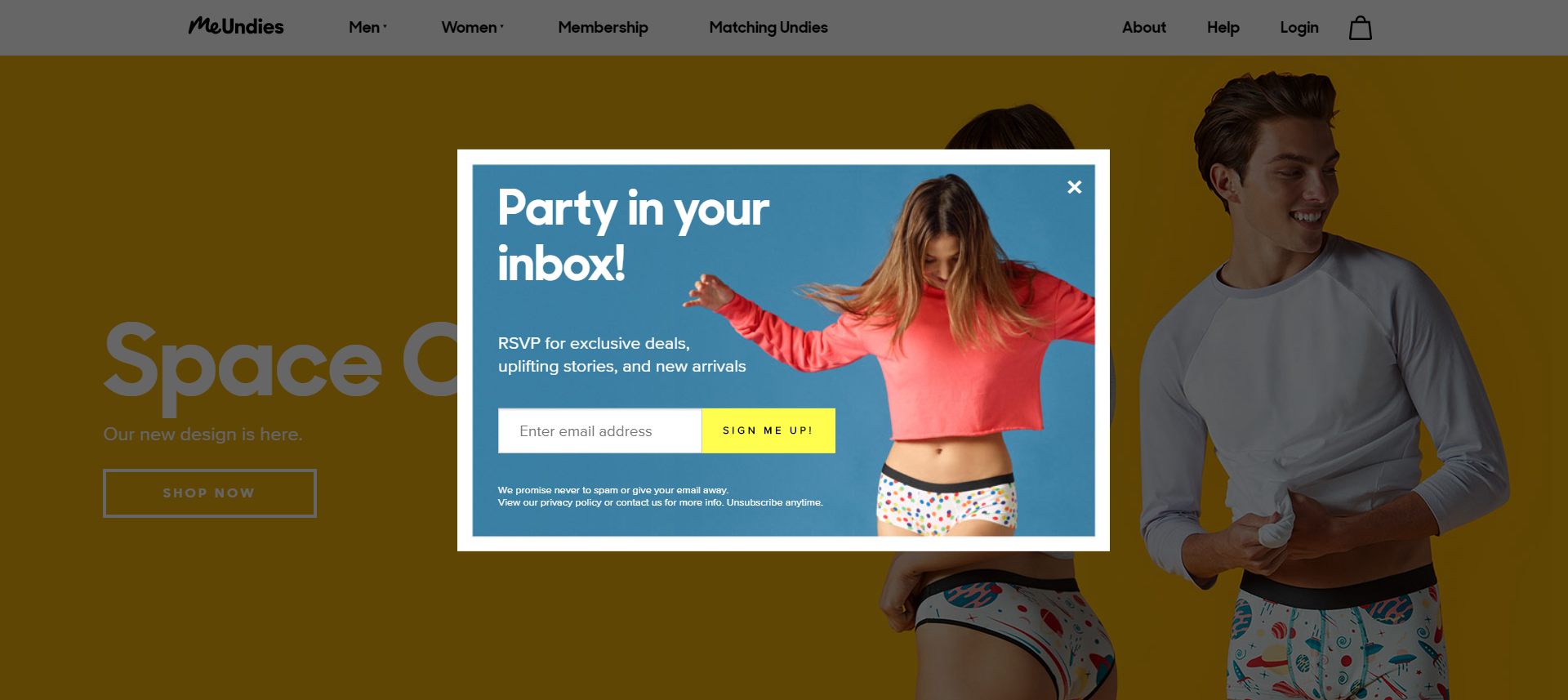
Note, again, that the focus is on what the individual will receive from the offer—with a reassurance of privacy and risk-mitigation, to boot.
Contrast the above examples with the following:
Here, the brand unwittingly makes their re-engagement campaign all about themselves (as opposed to focusing on the value they bring to the customer). Basically, the message here is “We want you back because we need your business.” Needless to say, this isn’t the best way to go about re-engaging those who have been incommunicado for an elongated period of time.
Once you’ve communicated the value of your offer, you also need to make it easy for them to take action. A strong, singular call-to-action is vital for getting your target to take the next step you have planned out for them.

In each of the above examples, the path to further engagement is crystal clear for the recipient. Since your goal is to engage your target when their propensity to take action is highest, you want to ensure they know exactly what’s needed from them in order to do so.
As complex as behavioral targeting can get, the premise is quite simple:
- Figure out when your individual customers are most likely to engage further with your brand
- Deliver the exact offer of value that will get them to take action
- Get out of the way, and allow them to move forward in their buyer’s journey


